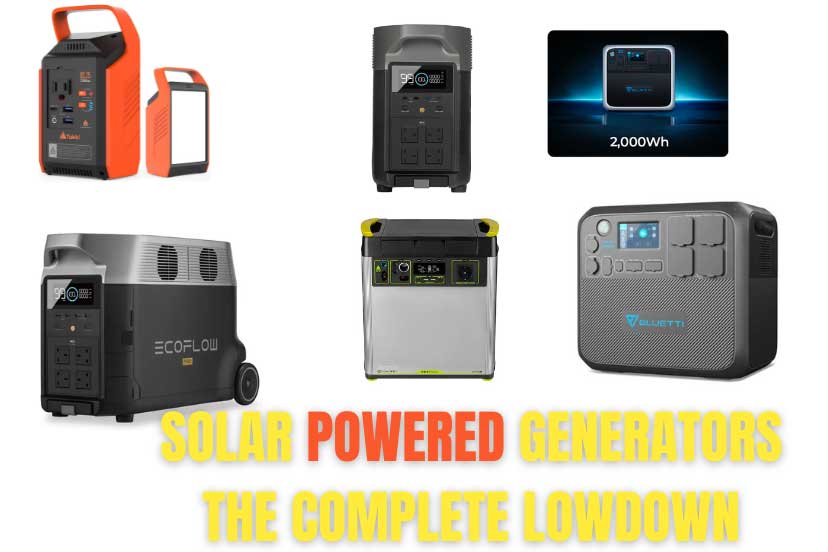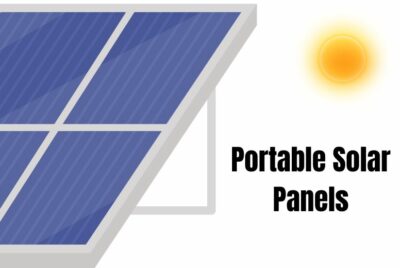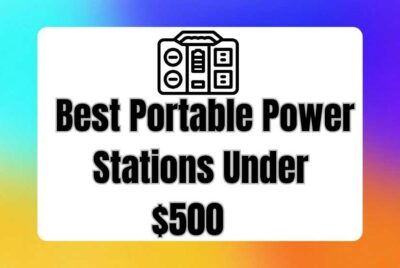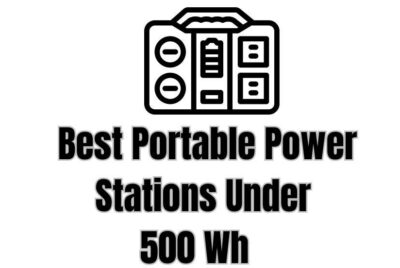Solar Powered Generators – The Complete Lowdown
Solar powered generators are an excellent alternative to traditional gas-powered generators. They are environmentally friendly, quiet, and can provide power for a variety of applications. In this blog post, we will explore how solar-powered generators work, what is needed for them to work optimally, their history, and the pros and cons of using them.
How Solar-Powered Generators Work
Solar-powered generators work by converting sunlight into electricity through the use of solar panels. The solar photovoltaic cells inside the panels take in the suns energy and change it into something more useful for home appliances and devices – direct current (DC) electricity. The DC electricity is next passed on to an inverter that transforms it into what households use – AC (alternating current) electricity, which is what appliances and electronics run on in your home.
Solar panels, the main components of solar generators, are packed with photovoltaic cells. When sunlight strikes these cells, it knocks electrons loose from their atoms. This disruption creates an electrical current, which is then harnessed and used as power.
To store the electricity generated by the solar panels, solar-powered generators use a battery bank. The battery bank stores the excess electricity generated during the day so that it can be used at night or during periods of low sunlight.
What is Needed for Solar-Powered Generators to Work Optimally
A solar generator is essentially a portable solar power system. It’s three parts must work in a harmonious sequence.
- The solar panels, collect sunlight and convert it into direct current (DC) electricity.
- The battery then stores this energy for later use.
- The inverter converts the stored DC electricity into alternating current (AC), which is the type of power needed for most appliances and devices.
To work optimally, solar-powered generators require sunlight. The more sunlight the solar panels receive, the more electricity they will generate. It is important to place the solar panels in a location that receives as much sunlight as possible.
In addition to sunlight, solar-powered generators require the battery bank to store the excess electricity generated by the solar panels. The battery bank should be large enough to store enough electricity to power your appliances and electronics for the desired amount of time.
Several factors influence the efficiency and performance of solar powered generators. First and foremost is sunlight exposure. The more direct sunlight the solar panels receive, the more electricity they can produce. This means that geographic location, time of day, and season can all affect a solar generator’s output.
Secondly, the size and quality of the solar panels and battery come into play. Larger, high-quality panels can collect more sunlight and thus generate more electricity. Similarly, a larger and more efficient battery can store more energy for later use.
Lastly, the inverter’s efficiency matters. Not all inverters convert DC to AC at the same rate, and losses in this conversion process can reduce the usable power output.
History of Solar-Powered Generators
The history of solar-powered generators dates back to the 1800s when scientists first discovered the photovoltaic effect. The photovoltaic effect is the process by which sunlight is converted into electricity. However, it wasn’t until the 1950s that solar cells were first used to power small electronic devices.
Physicist Alexandre Edmond Becquerel discovered the photovoltaic effect in the mid 19th Century. However, it wasn’t until the 1950s that solar power became a practical reality, thanks to Bell Labs’ development of the first working solar cell.
The first solar powered generators were bulky and inefficient, but technological advancements over the decades have greatly improved their performance and convenience. Today, solar generators are portable, reliable, and increasingly popular as a source of renewable energy.
In the 1970s, solar-powered generators began to be used in remote locations where traditional power sources were not available. Today, solar-powered generators are used in a variety of applications, including camping, emergency preparedness, and off-grid living.
Pros and Cons of Using Solar-Powered Generators
Pros
- Environmentally friendly
- Quiet
- Low maintenance
- No fuel required
- Can be used in remote locations
- Long lifespan
Cons
- Expensive upfront cost
- Limited power output
- Dependence on sunlight
- Battery bank requires regular maintenance
Solar Powered Generators Deep Dive on The Transfer of Energy To Storage
Solar panels take the free energy provided by the sun and convert it so it can be used as electricity by a clever process known as the photovoltaic effect. The photovoltaic effect is the process by which sunlight is converted into electricity. Solar panels are made up of photovoltaic cells that are made of layers of silicon, a semiconductor material.
When the panels receive sunlight, the photons in the silicon atoms are shaken loose, and this creates a lot of excitement – they start to flow. This flow of electrons is called a current, and it is what generates the electricity. The solar panels are connected to an inverter that converts the DC electricity directly to useable AC power.
To store the electricity generated by the solar panels, these portable solar generators use a battery bank. The battery bank is made up of a series of batteries that are connected together to store the excess electricity generated by the solar panels. The battery bank should be large enough to store enough electricity to power your appliances and electronics for the desired amount of time.
The transfer of electricity from the solar panels to the battery bank is done through a charge controller. The charge controller is responsible for dispensing the electricity generated from the solar panels into the battery bank. This is monitored and managed by the charge controller to ensure the battery does not get a spike in electrical current, and it stops it from being damaged and over or under charged.
The transfer of electricity from the battery bank to the inverter is done through a power inverter. The power inverter is essential as it will convert the electricity (DC) that the battery bank is storing into useable power. In other words DC is transformed into AC electricity. This is important as it then can be used to run home appliances and any type of device and electronic that can be run with electricity. Everything from your dishwasher, oven, electric shower right through to your phone and TV and even your RV. Some people even have a go at charging their electric vehicle with them.
It is important to note that the efficiency of the transfer and storage of electricity from the solar panels to the battery bank and then to the inverter is dependent on the quality of the equipment used. High-quality charge controllers and power inverters can improve the efficiency of the system and reduce the risk of damage to the batteries and electronics.
Understanding the Trade-Offs
Like all technologies, solar powered generators come with their own set of advantages and disadvantages. On the plus side, they are environmentally friendly, reducing reliance on fossil fuels and decreasing greenhouse gas emissions. They also provide a reliable source of power in remote locations or during power outages. Additionally, once set up, their operation cost is minimal as sunlight is free.
However, they do have some drawbacks. Their performance is heavily dependent on sunlight, meaning they are less effective in cloudy or rainy conditions. They also require a significant initial investment, although this can be offset by long-term energy savings. Lastly, they need regular maintenance to keep them in good working order.
Common Questions
How do solar powered generators work?
Solar powered generators operate by converting the energy from sunlight into usable electricity. The sun’s rays are captured by solar panels, which transform this solar energy into useable home DC (direct current) electricity. An inverter in the system then converts this DC electricity back into (AC) alternating current, because home appliances and devices work on the AC range.
What is needed for solar powered generators to work optimally?
For solar powered generators to perform at their best, they need a location with plenty of direct sunlight throughout the day. The solar panels should be positioned at the best angle that aligns them directly under the sun. Models like EcoFlow even have optional solar trackers. These will automatically swivel and adjust so that your solar panel achieves the maximum amount of sun exposure.
The system also requires an inverter to change the DC electricity into AC, and a battery storage system for storing extra power to be used when the sun isn’t shining. Keeping the solar panels clean and maintaining the system regularly also helps to ensure its efficiency.
How long do solar generators last?
The lifespan of a solar generator can vary, but typically, you can expect high quality panels to last between 25 to 35 years. Some portable power stations which is the unit that stores the battery and your appliances plug into, can last up to 10 years. Many last longer, but their batteries begin to diminish.
How has the efficiency of solar panels improved over the last 20 years?
Over the past two decades, solar panel efficiency has improved substantially. Technological advancements and design improvements have led to the creation of solar panels that can convert a larger percentage of sunlight into electricity. Some of the best solar panels available today can reach efficiencies of over 20%.
What are the pros and cons of solar powered generators?
Solar powered generators offer a number of benefits. They are a renewable energy source, can reduce electricity bills, and provide a potential source of off-grid power. They also produce clean, fume free energy. However, they also have their downsides. These include a high initial cost, dependence on weather conditions for performance, and the need for substantial space for installation.
What are some of the advancements in solar panel technology?
There have been several notable advancements in solar panel technology in recent years. These include the development of thin-film solar cells, III-V solar cells, organic photovoltaic solar cells, and perovskite solar cells. Each of these technologies has its own unique benefits and potential applications.
Can I install a solar generator myself?
While it is possible for someone with the necessary skills and knowledge to install a solar generator, it’s generally recommended to hire a professional if you are installing roof panels, or connecting your generator to your home grid. This is because the installation involves dealing with electricity and building structures and requires a thorough understanding of local building and electrical and building/roofing codes.
Some basic models come with portable fold up panels and they don’t require any complex electrical skills other than connecting a lead to get going. Most of the solar generators in todays markeplace are designed to work as stand alone products with portable panels. You can get models that hook up to your home grid like from the likes of Jackery and Goal Zero. They need to be really powerful and also require a separe control panel to connect to your home circuits.
What is the cost of a solar generators system?
The price of a complete solar generator system is dependant on what you need. If it’s a simple portable power station combined with 1 or 2 solar panels that will cost less than a complete home integrated backup power system. On average, you could expect to pay anything from a few hundred dollars to several thousand dollars. This cost typically includes the solar panels, inverter, battery storage system, and installation. Some models like the Takki T88 cost less than $100.
Can a solar generator power my entire house?
Whether a solar generator can power a whole house depends on the size of the generator and the energy usage of the house. A large solar generator may be able to provide enough power for most or all of a home’s needs, especially if the home is energy-efficient.
Are solar generators reliable?
Yes, solar generators are typically very reliable. They have few moving parts, which reduces the chances of mechanical failure. Their reliability largely depends on how much sunlight they receive. If they’re properly maintained and installed in a location that gets ample sunlight, they should provide a steady supply of power. If there is no sunlight most having triple charging options, AC power, car charging and solar.
Conclusion
Solar powered generators are a remarkable testament to human ingenuity and our ongoing quest to use free energy. While they are not without their limitations, their benefits are undeniable. As technology continues to evolve, so too will our capacity to harness the power of the sun. The future of solar energy is bright indeed.




